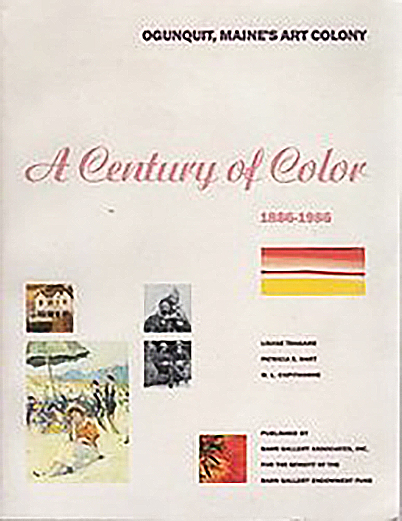
OGUNQUIT MAINE'S ART COLONY
Louise Tragard
Louse Tragard is the author of, "A century of Color. 1886 - 1986: Ogunquit Maine's Art Colony. ( Available at the Ogunquit Museum of Art and Amazon)
Since the late 1800's, Ogunquit has attracted an eclectic variety of artists, all of whom helped create a richly textured art colony and a place to live and paint. At first it was Ogunquit's Old World natural beauty and charm that brought artists here. As they watched the poetry of fishermen and their small dories, streams that quietly meandered around hay fields and surf that glistened and pounded the rocky shore, those first artists rendered romantic scenes that inspired others to see what they were painting about.
Soon word of this poetic scene spread and more and more people wanted to experience what the artists saw. A rich comeraderie with fellow creative spirits began to grow and the local residents began to rent out cheap rooms or parts of their barns, telling those who would listen their charming tall tales. Great friendships and fun grew between the artists, locals and now more frequent city summer visitors who began to buy the artists' works and/or attend emerging summer art schools. Ogunquit began to provide big city artists with a summer respite filled with inspiration and a unique social life.
As new art trends emerged, they too found their expressions in Ogunquit's craggy coastline, bustling cove life and casual ambiance. People here cared less how you looked or dressed and how you adhered to social mores. What mattered more was your sense of humor and fun-could you kick back and tell a tall tale, did you still see poetry in the landscape? A rich cultural scene fostered even more creative expressions.
Today, though the scene has changed, there are still artists who find poetry in the landscape and want to keep the creative spirit alive. The cheap rooms and parts of barns are long gone, but the galleries and now the Ogunquit Summer School of Art strive to help people see what is still all around them in this “beautiful place by the sea".
Louise Tragard
A Century of Color
Louise Tragard
Louse Tragard is the author of, "A century of Color. 1886 - 1986: Ogunquit Maine's Art Colony. ( Available at the Ogunquit Museum of Art and Amazon)
Since the late 1800's, Ogunquit has attracted an eclectic variety of artists, all of whom helped create a richly textured art colony and a place to live and paint. At first it was Ogunquit's Old World natural beauty and charm that brought artists here. As they watched the poetry of fishermen and their small dories, streams that quietly meandered around hay fields and surf that glistened and pounded the rocky shore, those first artists rendered romantic scenes that inspired others to see what they were painting about.
Soon word of this poetic scene spread and more and more people wanted to experience what the artists saw. A rich comeraderie with fellow creative spirits began to grow and the local residents began to rent out cheap rooms or parts of their barns, telling those who would listen their charming tall tales. Great friendships and fun grew between the artists, locals and now more frequent city summer visitors who began to buy the artists' works and/or attend emerging summer art schools. Ogunquit began to provide big city artists with a summer respite filled with inspiration and a unique social life.
As new art trends emerged, they too found their expressions in Ogunquit's craggy coastline, bustling cove life and casual ambiance. People here cared less how you looked or dressed and how you adhered to social mores. What mattered more was your sense of humor and fun-could you kick back and tell a tall tale, did you still see poetry in the landscape? A rich cultural scene fostered even more creative expressions.
Today, though the scene has changed, there are still artists who find poetry in the landscape and want to keep the creative spirit alive. The cheap rooms and parts of barns are long gone, but the galleries and now the Ogunquit Summer School of Art strive to help people see what is still all around them in this “beautiful place by the sea".
Louise Tragard
A Century of Color